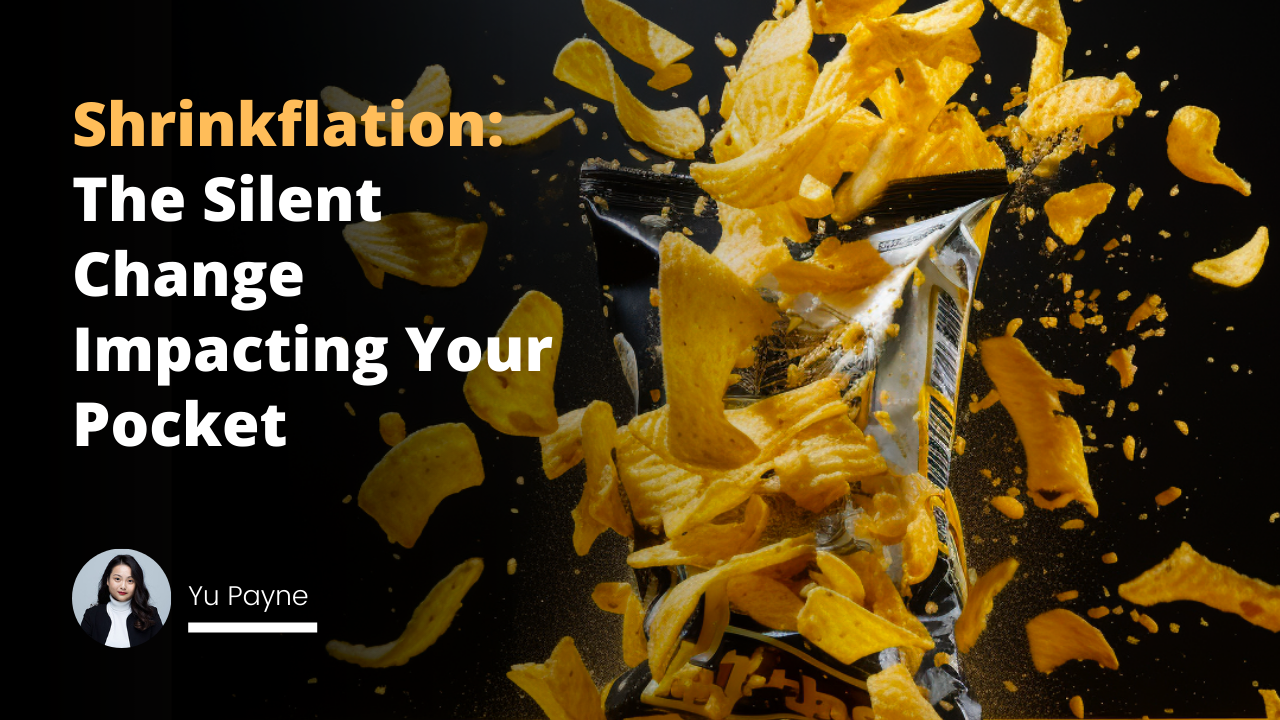
You might not have noticed, but that chocolate bar you love? It's gotten more minor over the last couple of years. No, it's not your imagination. It's a phenomenon called "shrinkflation."
From understanding its roots to examining recent examples, we unravel this covert trend silently affecting our pockets.
What is Shrinkflation? The Definition and Beyond
Shrinkflation is a term that's been gaining traction in commerce and among consumers. At its core, shrinkflation represents manufacturers' subtle strategy to address rising costs without alerting consumers through direct price hikes.
Understanding Shrinkflation
At first glance, shrinkflation is a simple reduction in product size. However, its implications are much broader. The term is a portmanteau of "shrink" and "inflation." Unlike traditional inflation, where prices increase, shrinkflation deals with the decreasing quantity or size of products.
The catch? The price remains unchanged.
Increasing prices can be a risky move for businesses. It's obvious and can lead to customer backlash or reduced sales. Instead, companies have found a more subtle way to manage their rising operational costs: by providing less of the product.
This tactic means they can offset the increased costs of raw materials, labor, and other factors without causing immediate consumer alarm.
The Art of Packaging
One of the most cunning aspects of shrinkflation is how it's presented. Companies invest in innovative packaging designs that give the illusion of the same quantity or even more, further disguising the reduced content. For instance, a chip bag might appear the same size, but the amount of chips inside or the weight can be less. The package may be filled with more air, or the base of a chocolate bar might be hollowed out subtly.
The Consumer's Perspective
For consumers, shrinkflation can be challenging to spot immediately. They may recognize the change when they feel like they're running out of a product sooner than usual or when they compare old and new packages side by side. This lag in realization is precisely what companies bank on. When consumers notice, they've often already adjusted to the new norm.
Shrinkflation serves as a testament to the lengths businesses will go to maintain profitability in the face of rising costs. As consumers, we must stay informed, compare products diligently, and hold manufacturers accountable when necessary.
A table comparing product sizes in 2020, 2021, 2022, and 2023 highlights the decrease.
Shrinkflation 2022 vs. Shrinkflation 2023: Spotting the Changes
The concept of shrinkflation is far from new. However, its presence has become increasingly evident in the past two years. This trend, while subtle, has consequences for consumers, as they're getting less for their money without necessarily realizing it immediately.
The Rise Shrinkflation in 2022
2022 marked a significant shift in the number of industries affected by shrinkflation. The economic challenges of that year, including supply chain disruptions, rising labor costs, and increased prices of raw materials, pushed many manufacturers to reconsider their product sizes. Toiletries, a daily necessity for most households, saw reductions in content. A shampoo bottle, for instance, might have held 10% less product than before. The snack industry wasn't spared either. As consumers indulged in comfortable eating amidst global uncertainties, they might've noticed their favorite snacks running out quicker, not due to increased consumption but reduced package content.
Shrinkflation in 2023: An Expanding Trend
If we thought shrinkflation reached its peak in 2022, 2023 proved us wrong. The trend broadened its horizons, touching even more sectors. Household goods, including detergents and cleaning agents, began to "shrink." A liter detergent bottle in 2022, by 2023, might only contain 950ml. The beverage sector also felt the pinch. Consumers, hoping to quench their thirst, found cans of soda having 10ml less or juice boxes not lasting as many servings as they used to.
The Art of Spotting Changes
For the vigilant consumer, these changes, though subtle, are noticeable. It often requires a combination of memory (recalling the original size or quantity) and keen observation (spotting differences in packaging or content). Sometimes, it's about reading the fine print, noting the amount mentioned, or looking at the serving sizes.
As we navigate the world of commerce in the mid-2020s, it's clear that shrinkflation is not just a temporary phenomenon but a lasting strategy manufacturers employ. As consumers, staying informed, sharing observations, and, when necessary, voting with our wallets will be essential tools in responding to this covert trend.
A comparative table shows products that faced shrinkflation in 2022 and 2023, with their respective size changes.
Shrinkflation Examples: When Less Really is Less
The potato chips and cookie examples emphasize the tangible impacts of shrinkflation. A family accustomed to sharing a 200-gram bag of chips during a movie night in 2022 found the same bag insufficient in 2023.
Similarly, the cookie lovers, expecting to relish a dozen cookies, found themselves two short in 2023, with the price stingingly constant.
Shrinkflation's impact stretches across various sectors. Here are some notable shrinkflation examples from recent years:
Food Items: Snacks, cereals, and ice cream tubs have all seen a reduction in quantity.
Household Items: Cleaning supplies like liquid detergents now come in smaller bottles but cost the same.
Cosmetics: Lotions and creams are being sold in slender tubes and jars, often with cleverly designed packaging that appears more significant than it truly is.
A table listing different product categories, the popular product affected, and the change in quantity or size.
Protecting Yourself from Shrinkflation's Impact
Knowledge is power. By understanding shrinkflation and staying informed, consumers can make smarter buying decisions. It's also beneficial to look at unit prices, compare brands, and consider the overall value of a product.
Additionally, considering a Risk Management Course can be an intelligent move, offering tools and strategies to understand and mitigate various market risks, including shrinkflation.
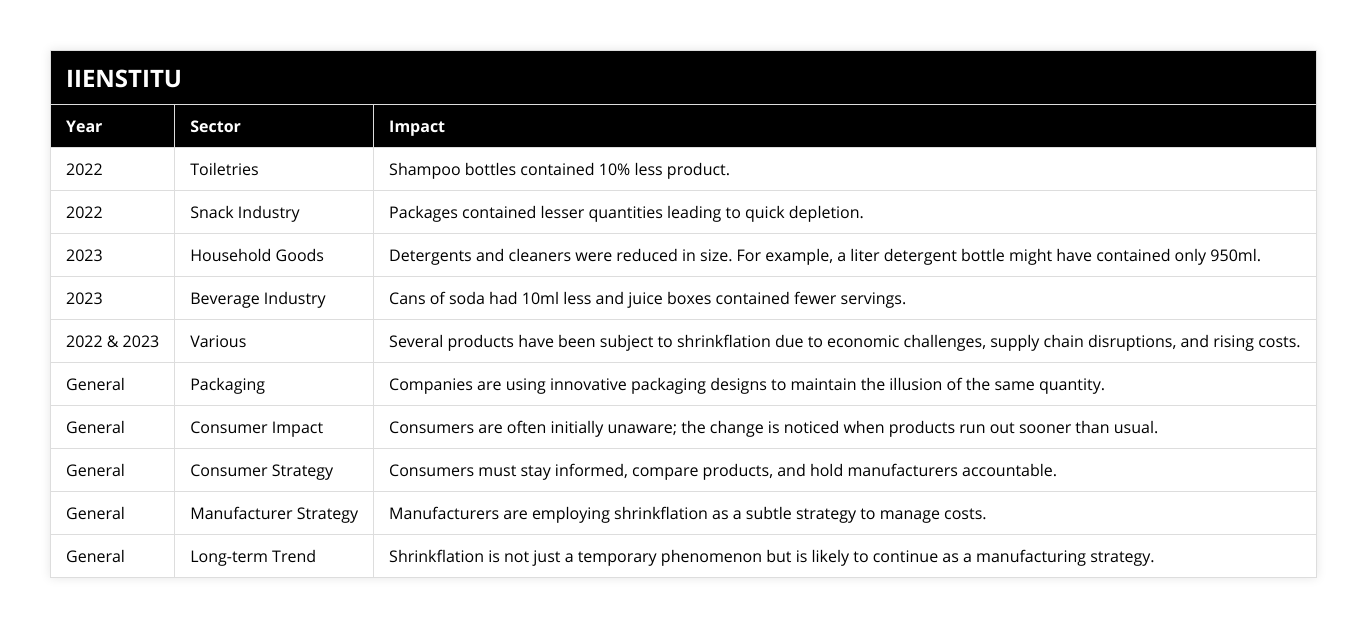
Frequently Asked Questions
Why do companies practice shrinkflation?
Companies constantly face increasing costs, be it raw materials, labor, or manufacturing.
Instead of directly passing these costs to consumers by hiking prices, they often opt for shrinkflation. This way, they can keep the product's price consistent while reducing its size or quantity, thus balancing their increased expenses.
Shrinkflation is a strategic decision that helps businesses maintain their profit margins without deterring customers with overt price increases.
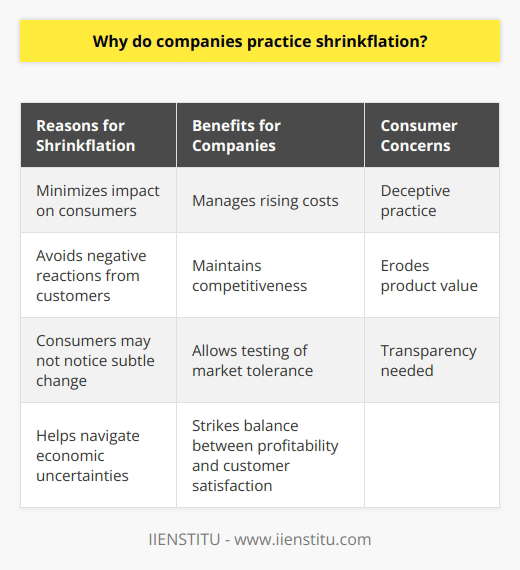
How can I spot shrinkflation?
Due to clever packaging, shrinkflation can be challenging to spot immediately.
One effective way is always to check the product's quantity or size. Compare it with your past purchases or look at unit prices. The per-unit price will often reveal if you're getting less for your money.
By being an informed shopper and paying attention to details, you can identify and navigate shrinkflation in the market.

Is shrinkflation deceptive?
The perception of shrinkflation can vary among consumers.
Some consider it necessary for companies facing rising costs, while others consider it a deceptive practice. While less transparent than a direct price hike, companies are not technically hiding the reduced size or quantity.
It's displayed, albeit sometimes discreetly, on the packaging.
Whether it's deemed deceptive or a necessary business strategy is subjective, but it undeniably underscores the importance of staying informed as a consumer.

How can consumers identify shrinkflation?
To identify shrinkflation, consumers should carefully compare product sizes, quantities, or packaging over time.
Look for any noticeable reductions in the amount of product you receive for the same price.
Reading product labels and checking unit prices (price per unit, e.g., price per ounce or price per sheet) can help consumers spot changes.
Compare unit prices: Calculate and compare the unit price of products to determine the best value.
Voice concerns: Contact the manufacturer or retailer to express dissatisfaction with shrinkflation.
Consider alternatives: Explore competing brands or similar products that offer better value for your money.
Buy in bulk: Purchasing larger quantities of non-perishable items can help mitigate the impact of shrinkflation.
Budget wisely: Adjust your budget to account for potential increases in the cost per unit of products due to shrinkflation.
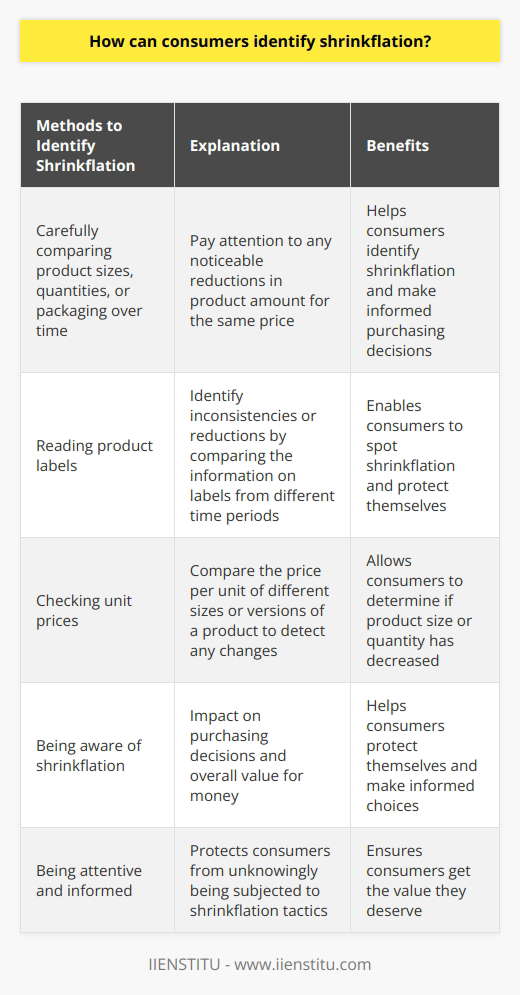
How can businesses minimize the impact of shrinkflation on consumer trust?
Businesses can take several steps to minimize the impact of shrinkflation on consumer trust:
Transparent communication: Clearly communicate any changes in product size or quantity to consumers through labels or packaging.
Justify changes: Explain the reasons for shrinkflation, such as rising production costs or quality improvements.
Maintain product quality: Ensure that the product's quality remains consistent despite any reductions in size or quantity.
Offer value-added features: Include additional features or benefits to offset the reduction in size or quantity.
Monitor feedback: Listen to customer feedback and be responsive to concerns, adjusting pricing or product offerings if necessary.
By addressing consumer concerns and maintaining transparency, businesses can help build and maintain trust even when implementing shrinkflation.
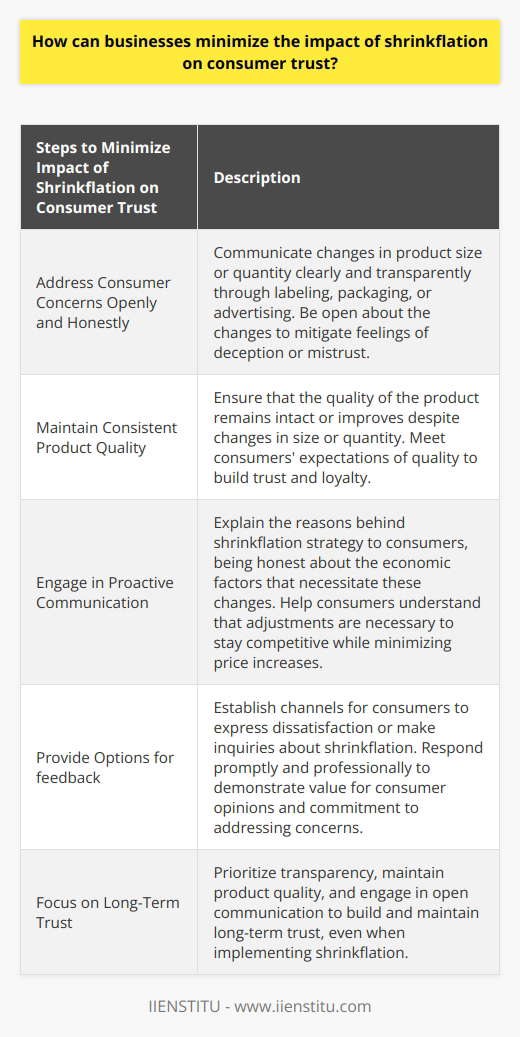
How can we stop shrinkflation?
Shrinkflation is a phenomenon where the size or quantity of a product is reduced while the price remains the same or even increases.It's a way for companies to maintain their profit margins without consumers immediately noticing the price increase. To address shrinkflation, you can take several steps:
Stay Informed: Be aware of the products you regularly purchase and their sizes or quantities. If you notice a significant reduction in size without a corresponding reduction in price, consider alternatives or voice your concerns to the manufacturer.
Read Labels: Check product labels and packaging carefully. Manufacturers are usually required to disclose changes in quantity or size on the packaging.
Consumer Advocacy: Support consumer advocacy groups or organizations that monitor and report on such practices. These groups often pressure companies to maintain transparency and fair practices.
Complain: If you encounter shrinkflation, consider reaching out to the manufacturer or retailer directly. They may respond to consumer feedback and reconsider their product sizing strategies.
Shop Smart: Be a savvy shopper. Look for alternatives, compare prices per unit or weight, and consider buying in bulk when feasible.
Government Regulations: Lobby for government regulations that require transparency in product sizing and pricing. Some countries have laws that regulate how products should be labeled to prevent deceptive practices.
Market Competition: Support brands and companies that maintain fair and consistent pricing practices. Competition can encourage businesses to avoid shrinkflation to remain competitive.
Consumer Education: Educate yourself and others about shrinkflation so that more consumers are aware of this practice and can make informed choices.
Boycott: In extreme cases, consider boycotting products or brands that engage in excessive shrinkflation. This can send a strong message to companies about the importance of fair pricing and product sizing.
Regulatory Intervention: If shrinkflation becomes a widespread and significant issue, government regulatory bodies may intervene to protect consumers' interests by implementing stricter regulations or investigating deceptive practices.
Remember that while it's challenging to completely eliminate shrinkflation, consumer awareness and advocacy can help reduce its prevalence and encourage businesses to maintain transparency and fairness in their pricing practices.
